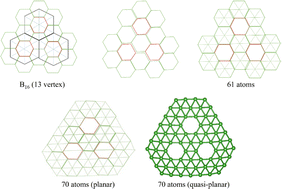A topological path to the formation of a quasi-planar B70 boron cluster and its dianion†
Abstract
In view of the competing assignments regarding the most stable isomer of the B70 boron cluster including the quasi-planar and bilayer structures, we reinvestigated the structural motifs of B70 using a genetic algorithm for structure search (MEGA) in conjunction with density functional theory computations using the PBE functional. The quasi-planar structure was also constructed using the topological leapfrog algorithm. The latter search aimed to give us unique insight into its formation and the growth pattern of boron clusters. Also, the di-anionic state of B70 was explored. Our extensive search suggested a competition between the quasi-planar, tubular and bilayer isomers for the ground state of B70 in both neutral and dianionic states. While the bilayer form is more stable in the neutral state, the quasi-planar counterpart becomes more stable in the dianionic B702−. The stability arises due to the fact that the B702− dianion possesses 50 π electrons that satisfy the disk aromaticity model rule. These results tend to extend the stabilization of the quasi-planar structure upon negative charge addition previously found in small size boron clusters to larger sizes.



 Please wait while we load your content...
Please wait while we load your content...